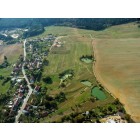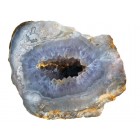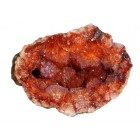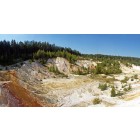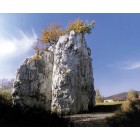The Moravian Karst is the largest karst and the most heavily karstified area in the Czech Republic. The karst area is located on a strip of Devonian limestone to the north of Brno. The character of the local landscape is produced by flat areas with a great many sink holes separated by deep canyon-like glens. Most of the water that flows from the non-karst part of the Drahany Highlands disappears beneath ground at the edges of the limestone, where complex cave labyrinths have been formed during long periods of geological development.
The northern part of the Moravian Karst is drained by the River Punkva and its tributaries. The cave system known as the Amateur Caves, which measures almost 35 kilometres with its connected caves, making it one of the largest cave systems in Central Europe, is found here.
The main cave system in the middle part of the Moravian Karst is the twelve-kilometre-long Rudice Sink – Býčí Skála. The most famous cave in the southern part of the karst is the Ochoz Cave, almost two kilometres in length.
There are now more than 1,100 recorded caves in the Moravian Karst. Evidence of long extinct life forms and the development of human society has been preserved in many of them. Evidence of the oldest settlement of the Moravian Karst by Neanderthal man more than 120,000 years ago has been found in the Kůlna Cave. Remarkable carvings of horses and bison on horse ribs have also been found in the Pekárna Cave. They were made by horse and reindeer hunters and are estimated to be between 11,000 and 13,000 years old. The caves are also the principal magnet for tourism in the karst.
The area’s geological bedrock and broken terrain, its location on the border between Pannonian and Hercynian regions and the occurrence of Carpathian species are the reasons for the presence of specific plant and animal communities. The cave fauna is particularly remarkable. Bats, of which twenty-one species have been found here to date, are the most famous examples. Numerous species of invertebrates, which are perfectly adapted to life in absolutely darkness, also live in the caves of the Moravian Karst, however. Many of them have been described as species new to science. The critically endangered species of plants here include, for example, the glacial relict Alpine bells (Cortusa matthioli) which grows on the rock wall of the Macocha Gorge, the only place it can be found in the Czech Republic. Forests with a largely natural species composition cover almost 60 % of the area.
The northern part of the Moravian Karst is drained by the River Punkva and its tributaries. The cave system known as the Amateur Caves, which measures almost 35 kilometres with its connected caves, making it one of the largest cave systems in Central Europe, is found here.
The main cave system in the middle part of the Moravian Karst is the twelve-kilometre-long Rudice Sink – Býčí Skála. The most famous cave in the southern part of the karst is the Ochoz Cave, almost two kilometres in length.
There are now more than 1,100 recorded caves in the Moravian Karst. Evidence of long extinct life forms and the development of human society has been preserved in many of them. Evidence of the oldest settlement of the Moravian Karst by Neanderthal man more than 120,000 years ago has been found in the Kůlna Cave. Remarkable carvings of horses and bison on horse ribs have also been found in the Pekárna Cave. They were made by horse and reindeer hunters and are estimated to be between 11,000 and 13,000 years old. The caves are also the principal magnet for tourism in the karst.
The area’s geological bedrock and broken terrain, its location on the border between Pannonian and Hercynian regions and the occurrence of Carpathian species are the reasons for the presence of specific plant and animal communities. The cave fauna is particularly remarkable. Bats, of which twenty-one species have been found here to date, are the most famous examples. Numerous species of invertebrates, which are perfectly adapted to life in absolutely darkness, also live in the caves of the Moravian Karst, however. Many of them have been described as species new to science. The critically endangered species of plants here include, for example, the glacial relict Alpine bells (Cortusa matthioli) which grows on the rock wall of the Macocha Gorge, the only place it can be found in the Czech Republic. Forests with a largely natural species composition cover almost 60 % of the area.


